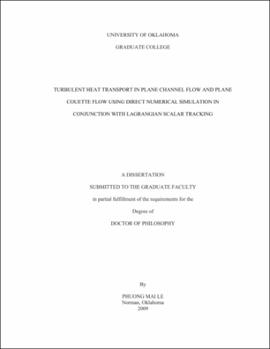| dc.contributor.advisor | Papavassiliou, Dimitrios V | |
| dc.creator | Le, Phuong Mai | |
| dc.date.accessioned | 2019-04-27T21:23:20Z | |
| dc.date.available | 2019-04-27T21:23:20Z | |
| dc.date.issued | 2009 | |
| dc.identifier | 99143933002042 | |
| dc.identifier.uri | https://hdl.handle.net/11244/318556 | |
| dc.description.abstract | Turbulent flows in plane channel and plane Couette are investigated using a direct numerical simulation in conjunction with Lagrangian scalar tracking of trajectories of thermal markers. The flow is for an incompressible Newtonian fluid with constant physical properties. In plane channel, the flow is driven by a constant mean pressure gradient in the channel. In plane Couette, the flow field is created by two infinite planes moving at the same velocity, but in opposite directions, forming a region of constant total shear stress. Heat markers are released into the flow from the channel wall, and the ground level temperature is calculated for dispersion from continuous line sources of heat. In addition, the temperature profile across the channel is synthesized from the behavior of these continuous line sources. It is found that the heat transfer coefficient for Couette flow is higher than that in channel flow for the same Prandtl numbers. Correlations are also obtained for the heat transfer coefficient for any Prandtl number ranging from 0.1 to 15000 in fully developed turbulence. | |
| dc.description.abstract | The behavior of elevated sources in turbulent channel flow and in turbulent plane Couette flow is also studied. It is found that the molecular Pr has negligible effects in the evolution of the marker cloud for Pr larger than 3, when the point of marker release is away from the viscous wall sublayer. However, when the markers are released close to the wall, the molecular effects on dispersion are strong. It is also found that total effective dispersion is higher in the case of plane Couette flow, where the total stress across the channel is constant. | |
| dc.description.abstract | Scaling of turbulent transport was examined based on two approaches, different than the currently widely used scaling based on viscous wall parameters. The first work on heat transfer scaling was done by Wei et al. (2005a). Their approach was based on analysis of the averaged heat equation. The turbulent flow domain was decomposed into layers, each with its characteristic transport mechanism. The applicability of this analysis for different turbulent velocity fields (plane Couette and plane Poiseuille flow) is investigated. The second approach was explored by Churchill and coauthors (Churchill and Chan, 1995; Churchill, 2000; Yu et al., 2001; Churchill, 2002). They proposed an algebraic model for the prediction of mean turbulence quantities. According to the Churchill model, fully developed flow and convection can be expressed as fractions, respectively, of shear stress and heat flux density due to turbulent fluctuations. The mean temperature profile can then be predicted when the velocity profile and the turbulent Prandtl number are given. The theoretical predictions have been found to agree with the data quite well for a range of Pr, but there are deviations at very high Pr. | |
| dc.description.abstract | The present study also investigates the mechanism of heat transfer away from the wall. The effects of the velocity field on the thermal field are studied. Characteristic length scales for heat transfer are calculated for fluids with Prandtl numbers between 0.1 and 100. Structures of larger scales are found to contribute to the transport of heat as the distance from the wall increases. Turbulent Prandtl numbers are calculated, showing that the turbulent Prandtl number is a function of the distance from the wall, but it does not depend on the fluid Prandtl number for high Prandtl numbers. | |
| dc.format.extent | 264 pages | |
| dc.format.medium | application.pdf | |
| dc.language | en_US | |
| dc.relation.requires | Adobe Acrobat Reader | |
| dc.subject | Turbulence--Mathematical models | |
| dc.subject | Fluid dynamics | |
| dc.title | Turbulent heat transport in plane channel flow and plane Couette flow using direct numerical simulation in conjunction with Lagrangian scalar tracking | |
| dc.type | text | |
| dc.type | document | |
| dc.thesis.degree | Ph.D. | |
| ou.group | College of Engineering::School of Chemical, Biological and Materials Engineering | |
